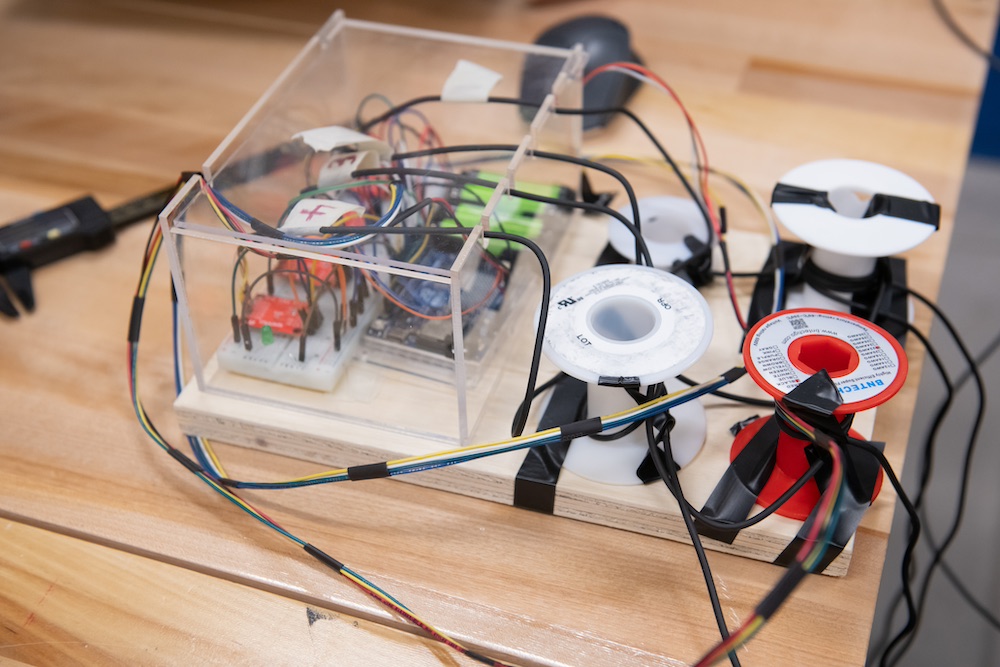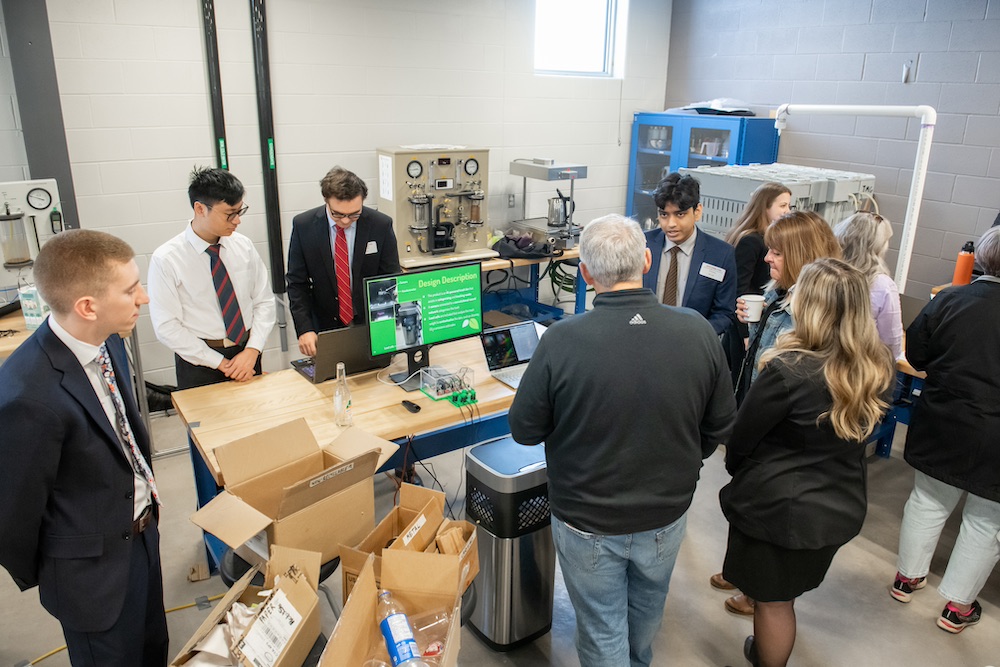"It's a unique project, and I got to work on it with a really talented team."
In the second, third, and fourth years of UPEI's Bachelor of Sustainable Design Engineering program, students form small groups to participate in a year-long design and implementation project with a corporate or community partner. Described as "an opportunity for students to act as engineering consultants for a company or organization, where teams of students team solve an actual technical challenge from the partner's operation", the design clinic program is a truly hands-on, real-world learning experience.
Sustainable Design Engineering students Ben Keizer, Tung Nguyen, SoumyaDeep Chowdhury, and Luke McCarvill and their TrashTech project centres around developing a reduction-focused domestic waste management product. It aims to conduct waste classification using machine vision, weight sensing, and meaningful data communication to users through a web application, much like Fitbit’s functionality and related smartphone application.
Tell me a little about your project.
Luke: "Most projects in the Sustainable Design Engineering program use the clinic model, where you work with a team to solve a problem for an industry partner to solve a problem for them. This was a unique project in the sense that this was the first project that didn't follow that scheme. SoumyaDeep and I pitched this project in our entrepreneurship course, and we were invited by the faculty to bring this project to life in our fourth-year design clinic because it fit the 'clean tech' motif that they were going for."
Ben: "We started working as a team last year to create a trash bin that could identify waste and sell it to consumers so that they could better understand waste output in their homes. So in that sense, we don't actually have a clinic partner or a client like every other team."
Luke: "We were instead given an advisory board of local entrepreneurs and business professionals that could provide us input. And what's also unique about our project is that we have retained all of the intellectual property rights for this project, unlike the design clinic projects where the organization that funds the project gets the IP."

What kinds of challenges did you face during the project?
Ben: "Just as we were getting ready for testing, three of the four load cells used to measure the weight of trash broke. That pushed us back by two to three weeks, which meant that we were really rushing to get all of our testing done. That was that was a bit of a frustration, a little bit of a scare. So we can actually show the advisory board that we've been working with for a year that we have actually done work. And this is how everything works together."
Luke: "There were certainly some software based challenges. Things individually might work perfectly fine on their own, but when you put everything together you realize that interactions you didn't expect can cause problems you didn't anticipate. Other than that, machine learning just takes a lot of data. Sometimes I was just here for hours taking photo after photo of different types of trash, rotating each piece, throwing it into the bin, just so the network would be trained on lots of varied images of trash and be more reliable."
SoumyaDeep: "Two days before presenting to the advisory board, the camera was only around 70% accurate. That was also a big scare for us. Luke actually brought me a charger to train the network at like 12:30 am because I didn't have a charger for my laptop. It was really stressful. And, you'll notice there's a GUI (Graphical User Interface) for the user part of the program, which was created in MATLAB. For anyone that's familiar with MATLAB, it's not really a language you want to create a GUI in, so that took longer than anything else that I've done for the project, just making buttons that click and disappear and putting backgrounds and icons on buttons."
What did you particularly enjoy about the project work?
Ben: "I enjoyed coding, because I've never really done much coding. I had to dive into Arduino and MATLAB more than I'm usually comfortable with, which was helpful because everyone I was working with has been very good at coding for majority of their degrees. It was nice to learn how to actually code well. I feel I've learned more about coding and how to deal with the different codes trying to mesh together into one system."
Luke: "I think the part that was really enjoyable for me was getting to bring to life an idea that me and some of my friends have had all the way back since high school. And so it really felt like more of a hobby project for most of it than work. Obviously, there were some frustrating moments, but I felt I felt really motivated to continue working on the project because it's something that I've been passionate about for a long time. And I got to work on it with a really talented team."
SoumyaDeep: "Most of the research I've done as an engineering student has been on machine vision and artificial intelligence, and for this project, we're using a convolutional neural network to identify the trash. It's an opportunity for me to mesh the research I'm interested in with the actual coursework and project work, and actually be able to see it work practically instead of in a program system I make or something like that. So yeah, that's what was really interesting to me, applying concepts of my chosen specializations into the practical environment."

What is unique about your specific project, and UPEI's Sustainable Design Engineering program?
Tung: "I think the main difference for our project is that we get to decide our own requirements, unlike other clinic projects where the partner company would have a set of requirements for the students to meet. Sometimes, that can be an advantage and a disadvantage. We get to choose what we want to work on and that can make decisions easier, but we may get confused by the number of options and actions we can take."
Luke: "I think the real benefit of our project is the free access to resources: financial, personnel, time, resources that you wouldn't otherwise have available as a start-up company. If we decide to continue with this project be creating a start-up business, we own the equity and the intellectual property to easily take it to the next level."
SoumyaDeep: "It's really nice that it's our intellectual property. I presented this project and my work on it to a number of grad schools, and I'm hoping to be able to continue working on this project with resources from grad schools or other opportunities."
Luke: "Of course, UPEI's traditional design clinic project model is still very advantageous for students because it puts students in a real-world scenario, solving a real problem for a company. Our project is just sort of a different take on it."
Ben: "The technicians and professors in the UPEI Faculty of Sustainable Design Engineering are absolutely terrific. They've been absolutely wonderful and really accommodating. Often when we have last-minute requests, they're like, 'oh, we can't do it, but we'll tell and show you how you can do it'."
Luke: "I would definitely echo that too. I think people know that the unique part of UPEI's program is that it's really project-focused right from year one straight through to the end. The people that make that possible are the technicians. Other engineering programs might have one capstone project and course in the fourth year, where there's one technician that you can go to for help. For us, we have lots of time throughout the day where we're working on our own time on our projects and we can walk up to one of half a dozen in-house Red Seal technicians—whether that be electricians, welders, machinists—they're ready to help us with our projects, which is really unheard of in any other program context. It's a really unique feature of UPEI's program for sure."
SoumyaDeep: "And, we would be remiss not to mention our project advisory board from Island Capital and assistance from Innovation PEI."
